Lucky Stars - Superstitious racers
Rossi, Foggy, Sheene - In this age of space technology, it's comforting to know that bike racers are a desperately superstitious bunch

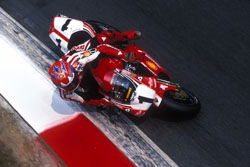
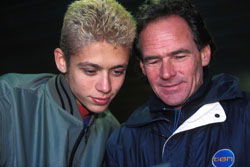
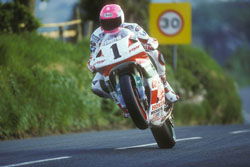
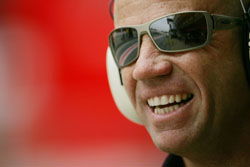
Conventional wisdom would argue that winning a motorcycle race requires skill, courage, physical fitness, stamina, experience and sophisticated, reliable and proven machinery. Seems logical enough. But there is another way to win races should you be lacking any of the aforementioned ingredients. If racers' personal beliefs have any merit, then wearing a green vest, a pair of Tweety Pie socks, some ten-year-old underpants, a St Christopher's medal and pre-scuffed leathers should bring enough combined good fortune to guarantee victory. In other words, almost every rider ever to throw a leg over a race bike has had a superstitious belief, a lucky item of clothing, or a lucky routine to help them perform well and stay safe. Motorcycle racers are a superstitious species. The nature of their chosen profession almost necessitates that they be so, for at any given point and for no apparent reason than 'bad luck', things can all go very wrong. Racers live at high speed on a fine, slick cut line between glory and disaster. It is such a fine line that, like fighter pilots, stunt men, specialist military forces and any other party involved in a high risk job, they seek any minute advantage - whether material or psychological - which might allow them to do their job better and more safely. In this case, the job involves pushing themselves and their fiercely powerful machines to go fractions of a second faster than they've ever gone before - and more crucially, to go faster than everyone else on the same track at the same time. It shouldn't be surprising that so many racers have lucky routines, numbers or garments of clothing. After all, belief is everything for a motorcycle racer. If he doesn't believe he's faster than his opponents, he's never going to beat them. So if belief is largely arbitrary, what's so strange about believing that a crusty old pair of pants is going to bring you good fortune? Superstition in competition pre-dates motorcycle racing by quite a way. In Medieval times, for example, ye olde Knights observed the custom of tying a favoured ladies' silk scarf to their lances for good luck. A few years later, early Isle of Man TT competitors did the same thing, although they tended to tie the scarf round their necks or wrists rather than to a lance. Well, most of them. The most obvious visual displays of superstition in sport today are the often annoyingly long routines practised by high jumpers and other field athletes. You know the sort - wipe your nose, turn in a circle, take three steps backwards, one step forwards, scratch your bollocks-type stuff. Bloody nonsense. Superstition is treated in the same way as religion by many people. They may not be firm believers, but they're not going to openly ridicule it... just in case. And when you're involved in a sport as dangerous as bike racing, it's unwise to tempt fate, and few do. Gruff, straight talking and as Northern as mushy peas, few people would argue that Carl Fogarty lacks any of the necessary qualities needed to win races. En route to four World Superbike titles he showed a determination and will to win bordering on the psychotic. But even he wasn't above believing in fate, luck and superstition, especially when racing in Ireland - the spiritual, Celtic home of a thousand superstitions, fairies and goblins. Having tried and failed on several occasions to win Ireland's insanely fast North West 200 pure roads race, he was given some advice by a local before the 1993 event. It was to prove invaluable. "You need a bit o' Irish luck Carl. Wear something green." After posting the fastest lap in practice, Carl went on to win both Superbike races and naturally put his success down to the green vest. A double win at Donington in the British Superbike championship followed as did victory in the Albacete round of WSB - all while wearing the same green vest. If Foggy wasn't superstitious before, he was now. Over the next eight years, he won 59 WSB races and wore the vest for 57 of them. On the two occasions he did forget the vest, he was panic-stricken. "I arrived at the track in Malaysia once and had left the vest in the hotel. I wouldn't ride without it but my team boss (Virginio Ferrari) said there wasn't time to go back for it so he blagged a green T-shirt from Kawasaki or someone, cut the sleeves off it and I wore that instead. And still won." And it would appear that the vest's magical powers haven't been completely expended. Michaela borrowed it back to take her bike test recently and passed first time. She probably looked a hell of a lot better in it too. T.W.O's road test editor Niall Mackenzie managed to race for 15 years without calling on Lady Luck's help, and he did pretty well too. Riding for nearly every factory team in 500 GPs, he notched up seven career podiums and finished fourth overall in 1990 on a Suzuki. He would only mount and dismount his bikes from the left side too. "Even if the mechanic presented the bike to me on the right I'd have to walk round it." When Mackenzie returned to the UK scene in 1996, he went well from the start of testing and rather than simply acknowledging that he was just a very good rider finally mounted on competitive machinery, the old trout searched for a deeper meaning - and found it in a pair of pretty purple socks. RS Taichi had unwittingly supplied these and hey presto, Mac found his form again. After all, they matched the purple Boost YZF750 he was riding at the time. And so began a relationship with the same pair (yep, you heard right) of socks for the next five years. "I guess you're clutching at straws with things like that but that's just the way it is." The socks were washed between races (reportedly) but never during a meeting - that's at least three full days in sweaty bike boots - and he never ordered a similar spare pair. Nice. Mackenzie reckons they may even have contributed to his retirement: "They were getting so full of holes during the 2000 season that I couldn't have gone on racing in them much longer. The toes were totally out of them and so were the heels." More sweat bands than socks then. But would Mackenzie's world have crumbled if he'd lost his socks? "No, I wouldn't have given a toss. I remember seeing John Kocinski in terrible tantrums at a hotel reception when the laundrette lost his lucky Bell Helmet T-shirt. I couldn't have been like that." Makes you wonder why he bothered at all then. Yes folks, despite our Whit 'following through' twice in the same underpants while racing, he courted Lady Luck's favour by wearing them for a full decade. A surefire way of scaring Miss Luck off one would have thought. Freudian psycho-analysts would insist such behaviour has its roots in childhood misfunctions but Whitham has an altogether simpler explanation. Like most racers, he has a set routine when it comes to getting his kit on for a race and this includes tucking his T-shirt (which has to be cotton) into his underpants. The boy always had style. "It stopped me shirt riding up me back and I hated it when me back protector rubbed against me bare back." Isn't there enough to think about when you're racing 20 other guys at 180mph? In his search for the perfect racing underpants, Whit came across a pair with "a reet good rubber band round t' top" to keep his T-shirt securely tucked in. After a couple of races in his new green wonderpants (note that colour again), he realised he was riding pretty well so he stuck with the pants - and the pants stuck to him, quite literally, for the next ten years. Whitham insists they were washed regularly (especially after he 'let loose' in them) but the years took their toll all the same. "They started to fray round t' rubber band but I kept wearin' them till they were only held together by t'stains." It was during Whitham's stint as factory Suzuki rider in WSB in 1997-98 that the pants finally became unwearable and he remembers making a conscious effort not to think about it when he first raced without them. "Come to think of it, me riding was crap after that (pardon the pun). But I had to say to meeself 'what bloody age are you now Whitham?' and forced meeself to forget about them." He doesn't have any lucky mascots now, insisting he "could never replace those pants", for which his wife Andrea is probably eternally grateful, but the pants did have to earn their keep in retirement. "I used them in me garage as a rag for cleaning bikes until there were absolutely nowt left of 'em." Definitive evidence that Yorkshiremen are actually tighter than Scots. And it would be safe to assume that the bikes Whit washed with his manky kegs were far dirtier afterwards than they ever were before. Next to garments of clothing, lucky numbers are prized by many riders and none was more famous than Barry Sheene's lucky number seven. He explains "Seven was always my favourite number even as a kid. I'd want seven this or seven that. Then when I went to Daytona in 1974 I asked what numbers were available. The Americans usually give you really high numbers but Mert Lawill (an American rider) had retired so seven was available and I thought 'brilliant'. The Americans made you wear your number on your helmet and leathers too so it was perfect and I kept the look when I got back to Europe." But the number sure as hell didn't prove lucky for him the following year at Daytona when his rear tyre blew out at 178mph on the banking leaving Sheene with a broken thigh, forearm, collarbone, wrist, six broken ribs and several fractured vertebrae. Proof, one would have thought, that lucky numbers don't always work but Sheene sees it differently "It was only good luck that saved me from death in Daytona". It appears that what the rest of us see as bad luck, racers interpret as good luck. That's what makes them different and allows them to carry on in the face of often overwhelming setbacks, danger and injuries. Sheene didn't put all his faith in a number though. He also wore a lucky T-shirt and underpants too just for good measure. After seeing a picture of himself on a podium wearing his Gary Nixon T-shirt and blue underpants (fetching Seventies Y front style naturally), it occurred to him that he'd won quite a few races wearing the same clobber so he stuck with it. "Gary was a great rider and a great friend of mine and when he came over to Europe from the States in 1970 he gave me some of his T-shirts. I always wore them and even when bad shit happened I realised I had been lucky to get away with it." Sheene's mum and dad gave him a lucky St Christopher when he started racing as another token of luck and when he lost it, pain awaited. "The chassis on my caravan broke once between races and as I was welding it I lost the St Christopher. At the very next race, my bike seized, threw me up the road and punctured my stomach so my mum and dad bought me another one." (St Christopher, not stomach). Like Foggy and his green vest, it doesn't seem to matter so much that it's the very same item racers wear, just that they've got something similar which they can associate with good luck. With so much emphasis on superstition, what happened when Sheene forgot his charms? His answer reveals the cockiness which is his trademark: "I'm not a bloody idiot. I don't forget things. I never forget things." Since Barry Sheene remains Britain's last 500cc world champion (he took the crown in 1976 and 77), perhaps our emerging road racing talent should take heed from the man and invest in some lucky charms. The year 2000 was Joey's 31st year of racing and the fact wasn't lost on him. In a terrible irony, Joey was sporting his legendary and lucky number three when he rode his fatal last race on his 125 Honda, but it wasn't enough to protect him from the number he feared most. Joey's 31st year of racing sadly proved to be his last. Just as Kevin Scwantz's lucky number 34 was withdrawn from GP racing when he retired in 1995, Joey's favourite number three will be forever withdrawn from the Isle of Man TT to honour the man who made the mountain circuit his very own. Reigning World Superbike champion Colin Edwards has a particularly bizarre superstition which patently doesn't work, but he perseveres nonetheless. Every time he wears a new set of leathers for the first time, he rolls around the paddock in them before going out on the bike. This oddball ritual started when Edwards once crashed wearing new leathers and ever since, he's scuffed them up round the paddocks of the world for good luck. GP wonderboy Valentino Rossi may have more than mercurial innate talent to thank for his dominance not just of 500s this year but in 250s and 125s in years gone by. The gangly superstar can be seen conducting his own weirdo ritual before he straddles his NSR500. Rossi hunkers down and grabs the right footrest of his bike almost as if he's shaking hands with the fearsome beast which could bite him so badly should it not be placated and revered by its rider before being mounted. For a few seconds Rossi bows his head and silently contemplates the bike which is soon to determine his fortunes. But Rossi being Rossi, it's difficult to tell if this is a sincere gesture or simply another caper to a) gain more publicity and b) outpsyche his rivals, few and far between though they are. But not everyone is ensnared by superstition to the same degree. If Lady Luck is needed in one race more than any other, it's probably the Isle of Man TT. Surely even the hardest of racers must seek favour with the Gods, fate, Lady Luck or some other deity before setting off down Glencrutchery Road at 180mph between the houses? In fact, one of the most famous superstitious rituals in bike racing can be observed on the Island between the airport and Douglas as racers pass the Fairy Bridge. Even hard as nails TT riders make the trip to the bridge to say hello to the Fairies before racing starts. It's bad luck not to after all. And what harm can it do? Your hard-arsed mates can't even take the piss, cos they all do it too. That's the whole thing with superstition - it's easier just to succumb to it and make a token gesture than it is to openly flaunt it and tempt providence. TT Lap record holder David Jefferies (125.6mph) may say hello to the Fairies each year, but for him, that's about as far as it goes. "I don't tend to get nervous before a race. I'll just sit on the pit wall and have a crack with the lads. I'm certainly not superstitious at all (must just like Fairies then). The only thing is that my sister tends to give me a pit board at Creg-ny-Baa every year but even that's more in her head than mine." Jefferies doesn't even have a set routine for kitting up like most racers and you've got to wonder how much cash he could make by bottling the recipe for such coolness. But he certainly wouldn't make much money from fellow TT stalwart Jim Moodie who has won seven races over the tortuous mountain circuit. "I always put on my right glove before my left but that's about it. And I think that's more from habit than anything else." So is he just not superstitious at all? "Not really. I wouldn't ride number 13 at the TT though, that's for sure." Simmo, who now manages the Dienza Ducati team in British Superbikes also had a bit of a ritual on Glencrutchery Road before a TT race. "I always said to whoever was holding my bike 'See you for a pint after the race' just to remind myself that I was coming back and not going out there to kill myself." He'd also refuse to have any numbers on his pit board before a race started. Most riders have the number of laps to go on their boards before the off but not Simmo. This dates back to his racing father Bill who was paranoid about it and since he nearly always signalled for Ian, it carried on from father to son. Some racers trusted to more conventional religions than superstition. Former 500 GP sultan of slide Randy Mamola says: "I was never superstitious but I believe in God and I always said a little prayer before each race that I would make it back safe. Not just for me - I prayed that every rider would come home safe that day. I still do." It must have worked since Randy finished second in the premier class four times in an age of legends and lives to tell the tale relatively unscathed. He currently commentates on the GPs for Eurosport. But Grant cites former Scottish racer Alex George as the daftest of all superstitious riders. "There was nothing in it between me and Alex for the British F1 title in 1980 and at the last round at Cadwell he qualified fourth on the front row and I was fifth on the second row. He told me he couldn't start from fourth for superstitious reasons and asked me to swop grid positions which I was obviously happy to do and I ended up beating him by half a bike's length!" Other racers try hard not to believe in superstition but sometimes succumb to it all the same. Steve Hislop is a good example. "I used to do the lucky socks and pants thing back in the early Nineties but after you've had a big crash you realise it's a load of f*****g bollocks." According to Hislop, his team manager Paul Bird is Mr Superstition himself. Before his first win at Silverstone in BSB this year, Bird casually shook Steve's hand on the grid before the off. He now insists on doing it before every race. But Hislop reveals how fickle a racer's relationship with Lady Luck can be as soon as fortunes take a turn for the worse. After being punted down from second to sixth at the Thruxton round of the BSB championship, he reckons the lucky handshake's gone tits up and that Tweety Pie's magic powers have all but evaporated. Must have washed them too often Steve. But he's not overly worried. "After breaking my neck at Brands last year, I'm a great believer in what will be will be so I just ride as hard as I can." Black cats, walking under ladders, breaking mirrors, superstition has been with us since the dawn of time and it doesn't look like scientific advances and explanations are going to make it a thing of the past. As long as there are things we don't understand, we'll continue to make abstract gestures to control them - or at least give us an illusion of control. In that sense, bike racers are no different to the rest of us save for the fact that they usually need a bit more luck on their side risking their lives on a racetrack than we do nipping down the shops. But then, what if you saw a black cat running in front of you on the way to the Quickee-Mart? Does it signify good luck or bad luck? Depends where you come from really. The point is, we all sort of know in our heart of hearts that it is pure baloney. But that doesn't stop us thinking about it or taking actions to counter it, just to be on the safe side. Would you race bike number 13 on Friday the 13th after breaking your bathroom mirror that morning? This feature was first published in the November 2001 issue of TWO |
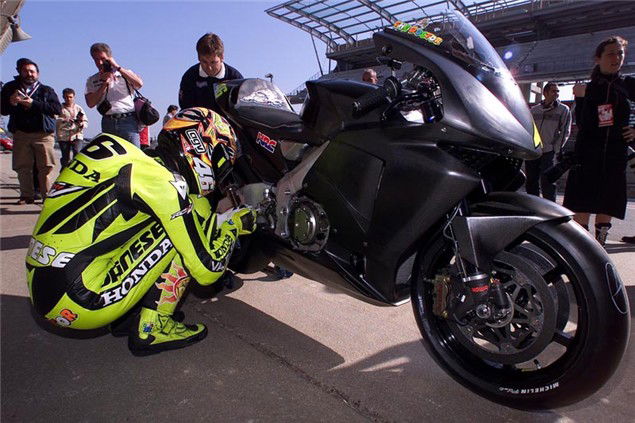
Conventional wisdom would argue that winning a motorcycle race requires skill, courage, physical fitness, stamina, experience and sophisticated, reliable and proven machinery. Seems logical enough.
But there is another way to win races should you be lacking any of the aforementioned ingredients. If racers' personal beliefs have any merit, then wearing a green vest, a pair of Tweety Pie socks, some ten-year-old underpants, a St Christopher's medal and pre-scuffed leathers should bring enough combined good fortune to guarantee victory.
In other words, almost every rider ever to throw a leg over a race bike has had a superstitious belief, a lucky item of clothing, or a lucky routine to help them perform well and stay safe. Motorcycle racers are a superstitious species. The nature of their chosen profession almost necessitates that they be so, for at any given point and for no apparent reason than 'bad luck', things can all go very wrong.
Racers live at high speed on a fine, slick cut line between glory and disaster. It is such a fine line that, like fighter pilots, stunt men, specialist military forces and any other party involved in a high risk job, they seek any minute advantage - whether material or psychological - which might allow them to do their job better and more safely.
In this case, the job involves pushing themselves and their fiercely powerful machines to go fractions of a second faster than they've ever gone before - and more crucially, to go faster than everyone else on the same track at the same time.
It shouldn't be surprising that so many racers have lucky routines, numbers or garments of clothing. After all, belief is everything for a motorcycle racer. If he doesn't believe he's faster than his opponents, he's never going to beat them. So if belief is largely arbitrary, what's so strange about believing that a crusty old pair of pants is going to bring you good fortune?
Superstition in competition pre-dates motorcycle racing by quite a way. In Medieval times, for example, ye olde Knights observed the custom of tying a favoured ladies' silk scarf to their lances for good luck. A few years later, early Isle of Man TT competitors did the same thing, although they tended to tie the scarf round their necks or wrists rather than to a lance. Well, most of them.
The most obvious visual displays of superstition in sport today are the often annoyingly long routines practised by high jumpers and other field athletes. You know the sort - wipe your nose, turn in a circle, take three steps backwards, one step forwards, scratch your bollocks-type stuff. Bloody nonsense. All this talk of superstition may sound like hokum, and maybe it is, but next time you're getting kitted up for a track day outing or a swift Sunday run, pay a bit more attention to the order in which you get dressed and you may well find you have your own 'lucky' routine that you weren't even aware of. Maybe you always get on your bike from the same side or you always put your left glove on before your right? Whatever.
Superstition is treated in the same way as religion by many people. They may not be firm believers, but they're not going to openly ridicule it... just in case. And when you're involved in a sport as dangerous as bike racing, it's unwise to tempt fate, and few do.
Gruff, straight talking and as Northern as mushy peas, few people would argue that Carl Fogarty lacks any of the necessary qualities needed to win races. En route to four World Superbike titles he showed a determination and will to win bordering on the psychotic.
But even he wasn't above believing in fate, luck and superstition, especially when racing in Ireland - the spiritual, Celtic home of a thousand superstitions, fairies and goblins.
Having tried and failed on several occasions to win Ireland's insanely fast North West 200 pure roads race, he was given some advice by a local before the 1993 event. It was to prove invaluable. "You need a bit o' Irish luck Carl. Wear something green." Whether at that point he believed in Leprechauns or not, Fogarty nevertheless rummaged through his luggage feverishly seeking out a green garment but found nothing. But a quick rummage through wife Michaela's bags (luggage that is) turned up a green Benetton vest which Fogarty wasted no time in slipping into. He assures us this wasn't a regular habit and he's never worn her knickers.
After posting the fastest lap in practice, Carl went on to win both Superbike races and naturally put his success down to the green vest. A double win at Donington in the British Superbike championship followed as did victory in the Albacete round of WSB - all while wearing the same green vest. If Foggy wasn't superstitious before, he was now.
Over the next eight years, he won 59 WSB races and wore the vest for 57 of them. On the two occasions he did forget the vest, he was panic-stricken. "I arrived at the track in Malaysia once and had left the vest in the hotel. I wouldn't ride without it but my team boss (Virginio Ferrari) said there wasn't time to go back for it so he blagged a green T-shirt from Kawasaki or someone, cut the sleeves off it and I wore that instead. And still won." More spooky however is that Carl's career ended on the day when his vest's useful life ended too. After crashing in Australia in 2000, the vest had to be cut off him because his injuries prevented it being taken off in the usual fashion as it had been for the past eight years. Carl says: "It's strange that we both ended our careers together. I've had it stitched back up now and still keep it."
And it would appear that the vest's magical powers haven't been completely expended. Michaela borrowed it back to take her bike test and passed first time. She probably looked a hell of a lot better in it too.

